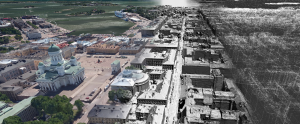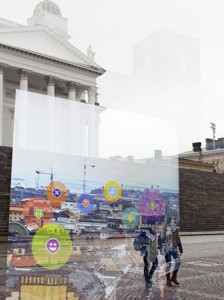For 2011, the city of Helsinki has led an offensive all-out transparency and open data, opening more than 1000 sets of data to the public. It joined this to 3 neighbouring municipalities Espoo, Vantaa and Kauniainen, in order to gather a panel of data giving the whole impression of this metropolis of 1.5 million people (equivalent to the metropolis of Lyon).
Amongst the data made available by the city, there is the State of the traffic and transport urban in real time as well as the meteorological measurements and sound pollution, energy consumption of the buildings, socio-demographic data on the population or how the money is spent in the city. It is even possible to track the activity of the plows in real time and find out if they are spent today in front of our doorstep.
Since November 2016, Helsinki has even made available and can be freely used two models of 3D city covering the entire city:
- A CityGML model, rich in semantics
- A 3D model of high Visual precision
In order to promote the use of these data models, 3d city model hackatons are now organized.
Model high resolution of Helsinki – source: City of Helsinki
Responsible for the management and publication of these data for the 4 partner municipalities, the Agency Helsinki Region Infoshare has developed API standardized to facilitate the use of these open data. In addition, it opens its offices every 2 weeks stakeholders to present the new sets of data available, chat with users and listen to their requests. The city of Helsinki encourage fervently the communities of developers of mobile applications, researchers and journalists to use its data, detailing where to find what data in what format, via its Portal Dev.hel.fi. It supports more good initiatives and occasionally gives a boost. The city has invested more than € 100,000 in 2013 and 2014 to achieve a digital 3D model of the city in CityGML (open standard) format, now freely downloadable.
But why so much effort to be determined to share its data, so that these money at the same time at exorbitant prices in the heart of Silicon Valley.
Helsinki – source: Jens Passoth
"Open data to the public can save money to a municipality, for example by displaying transparent costs or letting others view and analyze its spending" recounts Tanja Lahti, Director of Helsinki Region Infoshare. This sharing of data and knowledge is also a gold mine for the local IT companies that develop mobile applications related to the databases of the city. Ilkka Pirttimaa has developed the BlindSquare app to help the blind and sighted in their daily lives. This app shows the way to the next tram stop, communicating the next tram time, if it is late and how many minutes. The app knows also libraries that offer books in braille, and will guide the user over the floors (internally have been digitized by the city) to find the good book to the right RADIUS, or possibly go to the closest restroom between two chapters. The blind of Helsinki became with this app much more independent, some even to guide their labrador!
Open data boosts also participatory democracy, citizens being in turn consumers and voluntary contributors of this data exchange. They can easily notify City Hall a faulty hardware or a deterioration in their street, taking a picture with their smart phone and posting it on the app Fix-my-street accompanied by a short commentary. Generally, City Hall officials will participate in the following days.
This open data represents a significant cultural shift. She is at present in many other countries impossible. However, do not believe that the Finland is a lax State in terms of protection of the data or compliance with the sphere private, on the contrary: all published data must have been anonymized. In addition, any person handling these data received training of the person and copyright law. Is perhaps also a matter of open-mindedness.
More info:
- Article New generation city models information for Helsinki of TWU info (11.2016)
- Article Die transparent Stadt from the German magazine Brandeins (01.2016)
- Presentation of Tanja Lahti (06.2015)


